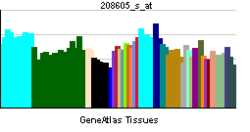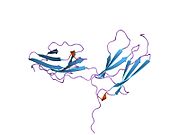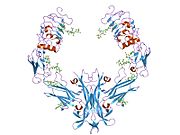- TrkA receptor
-
High affinity nerve growth factor receptor also known as neurotrophic tyrosine kinase receptor type 1 or TRK1-transforming tyrosine kinase protein or Trk-A is a protein that in humans is encoded by the NTRK1 gene.[1]
This gene encodes a member of the neurotrophic tyrosine kinase receptor (NTKR) family. This kinase is a membrane-bound receptor that, upon neurotrophin binding, phosphorylates itself (autophosphorylation) and members of the MAPK pathway. The presence of this kinase leads to cell differentiation and may play a role in specifying sensory neuron subtypes. Mutations in this gene have been associated with congenital insensitivity to pain with anhidrosis, self-mutilating behavior, mental retardation and cancer. Alternate transcriptional splice variants of this gene have been found, but only three have been characterized to date.[2]
Contents
Function
TrkA is the high affinity catalytic receptor for the neurotrophin, Nerve Growth Factor, or "NGF". As such, it mediates the multiple effects of NGF, which includes neuronal differentiation and survival.
The TrkA receptor is part of the large family of receptor tyrosine kinases. A "tyrosine kinase" is an enzyme which is capable of adding a phosphate group to a/the certain tyrosines on target proteins, or "substrates". A receptor tyrosine kinase is a tyrosine kinase which is located at the cellular membrane, and is activated by binding of a ligand via its extracellular domain. Other example of tyrosine kinase receptors include the insulin receptor, the Insulin-like growth factor 1 receptor, the MuSK receptor, the Vascular Endothelial Growth Factor (or VEGF) receptor, etc. The substrate proteins which are phosphorylated by TrkA include PI3 kinase.
Family members
TrkA is part of a sub-family of protein kinases which includes TrkB and TrkC. Also, there are other neurotrophic factors structurally related to NGF: BDNF (for Brain-Derived Neurotrophic Factor), NT-3 (for Neurotrophin-3) and NT-4 (for Neurotrophin-4). While TrkA mediates the effects of NGF, TrkB is bound and activated by BDNF, NT-4, and NT-3. Further, TrkC binds and is activated by NT-3.[3]
The Low Affinity Nerve Growth Factor Receptor
There is one other NGF receptor besides TrkA, called the "LNGFR" (for "Low Affinity Nerve Growth Factor Receptor"). As opposed to TrkA, the LNGFR plays a somewhat less clear role in NGF biology. Some researchers have shown the LNGFR binds and serves as a "sink" for neurotrophins. Cells which express both the LNGFR and the Trk receptors might therefore have a greater activity - since they have a higher "microconcentration" of the neurotrophin. It has also been shown, however, that in the absence of a co-expressed TrkA, the LNGFR may signal a cell to die via apoptosis - so therefore cells expressing the LNGFR in the absence of Trk receptors may die rather than live in the presence of a neurotrophin.
Role in disease
TrkA was originally cloned from a colon tumor; the cancer occurred via a translocation, which resulted in the activation of the TrkA kinase domain. However, TrkA itself does not appear to be an oncogene.
In one study, a total absence of TrkA receptor was found in keratoconus-affected corneas, along with an increased level of repressor isoform of Sp3 transcription factor.[4]
Regulation of TrkA
The levels of distinct proteins can be regulated by the "ubiquitin/proteasome" system. In this system, a small (7-8 kd)protein called "ubiquitin" is affixed to a target protein, and is thereby targeted for destruction by a structure called the "proteasome". TrkA is targeted for proteasome-mediated destruction by an "E3 ubiquitin ligase" called NEDD-4. This mechanism may be a distinct way to control the survival of a neuron. The extent and maybe type of TrkA ubiquitiniation can be regulated by the other, unrelated receptor for NGF, p75NTR [5].
Interactions
TrkA has been shown to interact with:
Small molecules such as amitriptyline and gambogic acid derivatives have been claimed to activate TrkA. Amitriptyline activates TrkA and facilitate the heterodimerisation of TrkA and TrkB in the absence of NGF. Binding of Amitriptyline to TrkA occurs to the Leucine Rich Region (LRR) of the extracellular domain of the receptor, which is distinct from the NGF binding site. Amitryptiline possess neurotrophic activity both in-vitro and in-vivo (mouse model).[22] Gambogic Amide, a derivative of Gambogic acid, selectively activates TrkA (but not TrkB and TrkC) both in-vitro and in-vivo by interacting with the cytoplasmic juxtamembrane domain of TrkA.[23]
References
- ^ Martin-Zanca D, Hughes SH, Barbacid M (April 1986). "A human oncogene formed by the fusion of truncated tropomyosin and protein tyrosine kinase sequences". Nature 319 (6056): 743–8. doi:10.1038/319743a0. PMID 2869410.
- ^ "Entrez Gene: NTRK1 neurotrophic tyrosine kinase, receptor, type 1". http://www.ncbi.nlm.nih.gov/sites/entrez?Db=gene&Cmd=ShowDetailView&TermToSearch=4914.
- ^ Benito-Gutiérrez E, Garcia-Fernàndez J, Comella JX (February 2006). "Origin and evolution of the Trk family of neurotrophic receptors". Mol. Cell. Neurosci. 31 (2): 179–92. doi:10.1016/j.mcn.2005.09.007. PMID 16253518. http://linkinghub.elsevier.com/retrieve/pii/S1044-7431(05)00223-X.
- ^ Lambiase A, Merlo D, Mollinari C, Bonini P, Rinaldi AM, D' Amato M, Micera A, Coassin M, Rama P, Bonini S, Garaci E (November 2005). "Molecular basis for keratoconus: lack of TrkA expression and its transcriptional repression by Sp3". Proc. Natl. Acad. Sci. U.S.A. 102 (46): 16795–800. doi:10.1073/pnas.0508516102. PMC 1283852. PMID 16275928. http://www.pnas.org/cgi/pmidlookup?view=long&pmid=16275928.
- ^ a b c d Koch, A; Mancini A, Stefan M, Niedenthal R, Niemann H, Tamura T (March 2000). "Direct interaction of nerve growth factor receptor, TrkA, with non-receptor tyrosine kinase, c-Abl, through the activation loop". FEBS Lett. 469 (1): 72–6. doi:10.1016/S0014-5793(00)01242-4. PMID 10708759.
- ^ Yano, H; Cong F, Birge R B, Goff S P, Chao M V (February 2000). "Association of the Abl tyrosine kinase with the Trk nerve growth factor receptor". J. Neurosci. Res. 59 (3): 356–64. doi:10.1002/(SICI)1097-4547(20000201)59:3<356::AID-JNR9>3.0.CO;2-G. PMID 10679771.
- ^ a b c Meakin, S O; MacDonald J I, Gryz E A, Kubu C J, Verdi J M (April 1999). "The signaling adapter FRS-2 competes with Shc for binding to the nerve growth factor receptor TrkA. A model for discriminating proliferation and differentiation". J. Biol. Chem. 274 (14): 9861–70. doi:10.1074/jbc.274.14.9861. PMID 10092678.
- ^ Song, Cheng; Perides George, Liu Ya Fang (February 2002). "Expression of full-length polyglutamine-expanded Huntingtin disrupts growth factor receptor signaling in rat pheochromocytoma (PC12) cells". J. Biol. Chem. 277 (8): 6703–7. doi:10.1074/jbc.M110338200. PMID 11733534.
- ^ MacDonald, J I; Gryz E A, Kubu C J, Verdi J M, Meakin S O (June 2000). "Direct binding of the signaling adapter protein Grb2 to the activation loop tyrosines on the nerve growth factor receptor tyrosine kinase, TrkA". J. Biol. Chem. 275 (24): 18225–33. doi:10.1074/jbc.M001862200. PMID 10748052.
- ^ Yamashita, H; Avraham S, Jiang S, Dikic I, Avraham H (May 1999). "The Csk homologous kinase associates with TrkA receptors and is involved in neurite outgrowth of PC12 cells". J. Biol. Chem. 274 (21): 15059–65. doi:10.1074/jbc.274.21.15059. PMID 10329710.
- ^ Nykjaer, Anders; Lee Ramee, Teng Kenneth K, Jansen Pernille, Madsen Peder, Nielsen Morten S, Jacobsen Christian, Kliemannel Marco, Schwarz Elisabeth, Willnow Thomas E, Hempstead Barbara L, Petersen Claus M (February 2004). "Sortilin is essential for proNGF-induced neuronal cell death". Nature 427 (6977): 843–8. doi:10.1038/nature02319. PMID 14985763.
- ^ Lee, R; Kermani P, Teng K K, Hempstead B L (November 2001). "Regulation of cell survival by secreted proneurotrophins". Science 294 (5548): 1945–8. doi:10.1126/science.1065057. PMID 11729324.
- ^ Wiesmann, C; Ultsch M H, Bass S H, de Vos A M (September 1999). "Crystal structure of nerve growth factor in complex with the ligand-binding domain of the TrkA receptor". Nature 401 (6749): 184–8. doi:10.1038/43705. PMID 10490030.
- ^ Ohmichi, M; Decker S J, Pang L, Saltiel A R (August 1991). "Nerve growth factor binds to the 140 kd trk proto-oncogene product and stimulates its association with the src homology domain of phospholipase C gamma 1". Biochem. Biophys. Res. Commun. 179 (1): 217–23. doi:10.1016/0006-291X(91)91357-I. PMID 1715690.
- ^ a b c d Qian, X; Riccio A, Zhang Y, Ginty D D (November 1998). "Identification and characterization of novel substrates of Trk receptors in developing neurons". Neuron 21 (5): 1017–29. doi:10.1016/S0896-6273(00)80620-0. PMID 9856458.
- ^ a b Nakamura, Takeshi; Komiya Misako, Sone Kiyoaki, Hirose Eiji, Gotoh Noriko, Morii Hiroshi, Ohta Yasutaka, Mori Nozomu (December 2002). "Grit, a GTPase-activating protein for the Rho family, regulates neurite extension through association with the TrkA receptor and N-Shc and CrkL/Crk adapter molecules". Mol. Cell. Biol. 22 (24): 8721–34. doi:10.1128/MCB.22.24.8721-8734.2002. PMC 139861. PMID 12446789. http://www.pubmedcentral.nih.gov/articlerender.fcgi?tool=pmcentrez&artid=139861.
- ^ Wooten, M W; Seibenhener M L, Mamidipudi V, Diaz-Meco M T, Barker P A, Moscat J (March 2001). "The atypical protein kinase C-interacting protein p62 is a scaffold for NF-kappaB activation by nerve growth factor". J. Biol. Chem. 276 (11): 7709–12. doi:10.1074/jbc.C000869200. PMID 11244088.
- ^ Geetha T, Wooten MW (February 2003). "Association of the atypical protein kinase C-interacting protein p62/ZIP with nerve growth factor receptor TrkA regulates receptor trafficking and Erk5 signaling". J. Biol. Chem. 278 (7): 4730–9. doi:10.1074/jbc.M208468200. PMID 12471037.
- ^ Jadhav T, Geetha T, Jiang J, Wooten MW (July 2008). "Identification of a consensus site for TRAF6/p62 polyubiquitination". Biochem. Biophys. Res. Commun. 371 (3): 521–4. doi:10.1016/j.bbrc.2008.04.138. PMC 2474794. PMID 18457658. http://www.pubmedcentral.nih.gov/articlerender.fcgi?tool=pmcentrez&artid=2474794.
- ^ Wooten MW, Geetha T, Babu JR, Seibenhener ML, Peng J, Cox N, Diaz-Meco MT, Moscat J (March 2008). "Essential role of sequestosome 1/p62 in regulating accumulation of Lys63-ubiquitinated proteins". J. Biol. Chem. 283 (11): 6783–9. doi:10.1074/jbc.M709496200. PMID 18174161.
- ^ Borrello, M G; Pelicci G, Arighi E, De Filippis L, Greco A, Bongarzone I, Rizzetti M, Pelicci P G, Pierotti M A (June 1994). "The oncogenic versions of the Ret and Trk tyrosine kinases bind Shc and Grb2 adaptor proteins". Oncogene 9 (6): 1661–8. PMID 8183561.
- ^ Jang SW, Liu X, Chan CB, Weinshenker D, Hall RA, Xiao G, Ye K. (June 2009). "Amitriptyline is a TrkA and TrkB receptor agonist that promotes TrkA/TrkB heterodimerization and has potent neurotrophic activity.". Chem Biol. 16 (6): 644–656. doi:10.1016/j.chembiol.2009.05.010. PMC 2844702. PMID 19549602. http://linkinghub.elsevier.com/retrieve/pii/S1074-5521(09)00177-X.
- ^ Jang SW, Okada M, Sayeed I, Xiao G, Stein D, Jin P, Ye K. (October 2007). "Gambogic amide, a selective agonist for TrkA receptor that possesses robust neurotrophic activity, prevents neuronal cell death.". Proc Natl Acad Sci U S A 104 (41): 16329–16334. doi:10.1073/pnas.0706662104. ISBN 0706662104. PMC 2042206. PMID 17911251. http://www.pnas.org/content/104/41/16329.long.
External links
Further reading
- Indo Y (2002). "Genetics of congenital insensitivity to pain with anhidrosis (CIPA) or hereditary sensory and autonomic neuropathy type IV. Clinical, biological and molecular aspects of mutations in TRKA(NTRK1) gene encoding the receptor tyrosine kinase for nerve growth factor.". Clin. Auton. Res. 12 (Suppl 1): I20–32. doi:10.1007/s102860200016. PMID 12102460.
- Micera A, Lambiase A, Stampachiacchiere B, et al. (2007). "Nerve growth factor and tissue repair remodeling: trkA(NGFR) and p75(NTR), two receptors one fate.". Cytokine Growth Factor Rev. 18 (3-4): 245–56. doi:10.1016/j.cytogfr.2007.04.004. PMID 17531524.
PDB gallery Protein kinases: tyrosine kinases (EC 2.7.10) Receptor tyrosine kinases (EC 2.7.10.1) Insulin receptor familyPDGF receptor familyFGF receptor familyVEGF receptors familyHGF receptor familyTrk receptor familyEPH receptor familyLTK receptor familyLTK · ALKTIE receptor familyROR receptor familyROR1 · ROR2DDR receptor familyPTK7 receptor familyRYK receptor familyMuSK receptor familyROS receptor familyAATYK receptor familyAXL receptor familyRET receptor familyuncatagorisedNon-receptor tyrosine kinases (EC 2.7.10.2) ABL familyACK familyACK1 · TNK1CSK familyFAK familyFES familyFRK familyJAK familySRC-A familySRC-B familyTEC familySYK familyReceptors: growth factor receptors Type I cytokine receptor Receptor protein serine/threonine kinase Receptor tyrosine kinase Fibroblast growth factor (1, 2, 3, 4)
Nerve growth factors: high affinity Trk (TrkA, TrkB, TrkC)
Somatomedin (Insulin-like growth factor 1)
VEGF (1, 2, 3)Tumor necrosis factor receptor Ig superfamily Other/ungrouped Categories:- Human proteins
- Tyrosine kinase receptors
Wikimedia Foundation. 2010.






